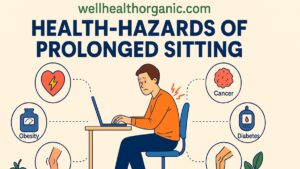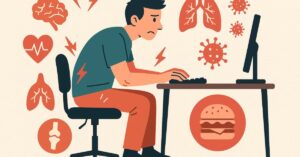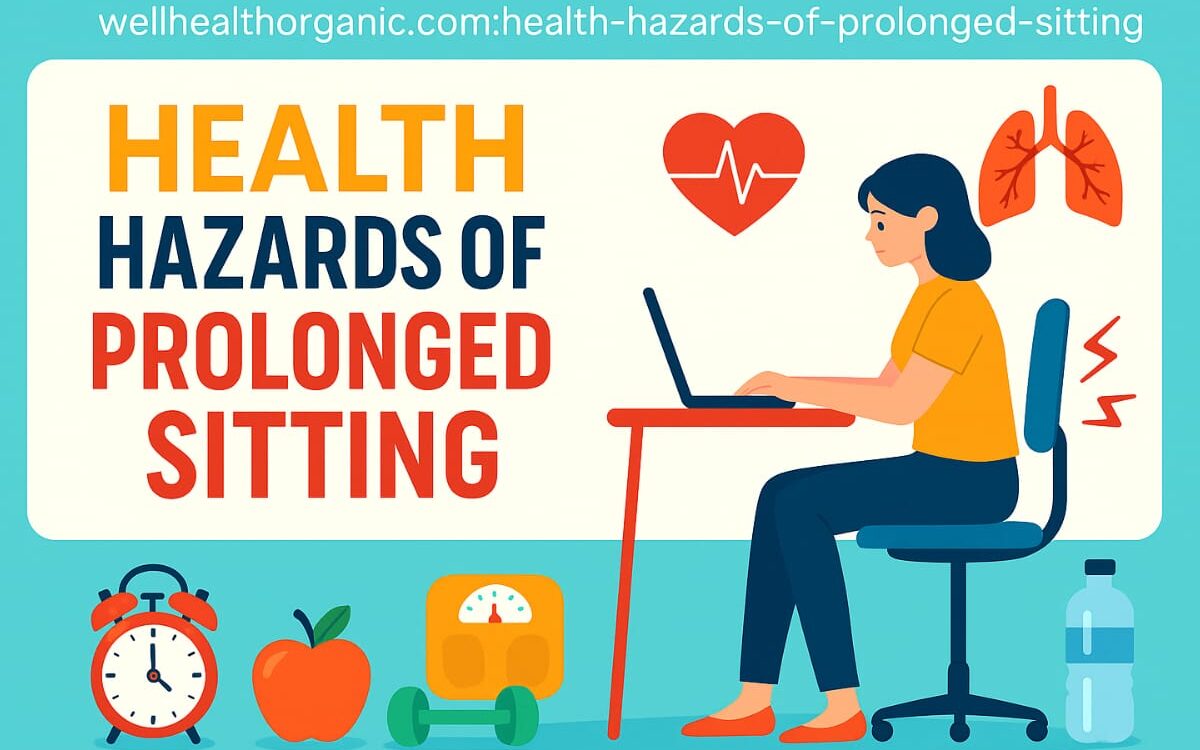Introduction
Today’s world is dominated by digital devices, where most people spend a significant amount of time sitting in front of office desks, computers, and mobile screens. This routine, which once seemed normal, is now proven by science to be extremely harmful to health. Prolonged sitting not only leads to physical issues like back and neck pain but also causes serious diseases such as heart problems, diabetes, and obesity. It’s like a slow poison that weakens the body internally. In this blog, we’ll discuss the negative effects of prolonged sitting on health, the diseases it can cause, and easy and effective ways to prevent them.For a healthy lifestyle, it’s essential to gain knowledge from informative platforms like wellhealthorganic.com:health-hazards-of-prolonged-sitting.
The Negative Effects of Prolonged Sitting on Health

When a person sits in one place for a long time, their body doesn’t move much. Every organ in the body works as a system, and every part needs to stay active. When you’re not moving, blood circulation slows down. Your muscles start to weaken, and energy isn’t used efficiently. This directly affects your metabolism—the process that turns food into energy. When metabolism slows down, your body doesn’t burn calories well, leading to weight gain.
Additionally, constant sitting weakens your bones and joints. Back pain, neck stiffness, and joint pain become common. Your eyes are also affected when you sit in front of a screen for long periods. People who don’t engage in physical activity are more likely to experience anxiety and depression because movement is closely linked to brain health. The human body is designed to stay active, and going against this natural design leads to health problems.
Finally, it’s essential to understand that prolonged sitting isn’t just a habit; it’s a lifestyle-related health risk. Everyone should take time to walk, stretch, or engage in some physical activity every day.Long sitting hours can silently harm your body, and wellhealthorganic.com:health-hazards-of-prolonged-sitting explains exactly how.The insights on wellhealthorganic.com:health-hazards-of-prolonged-sitting encourage readers to take regular breaks and stay active.
Explore wellhealthorganic.com:health-hazards-of-prolonged-sitting insights in Bato Manga Resume 100 guide.
Diseases Caused by Prolonged Sitting
Prolonged sitting is a habit that may seem comfortable and easy, but it’s actually extremely harmful to the human body. When you sit in one place for hours without physical movement, various processes within your body get disrupted, gradually damaging your health. Here are some diseases caused by this lifestyle:
Heart Diseases
When your body is not in motion, blood circulation slows down, increasing pressure on the heart. Fatty acids accumulate in blood vessels, potentially blocking arteries, which can lead to heart attacks, high blood pressure, and strokes.
Type 2 Diabetes
Without regular physical activity, the body doesn’t use insulin properly, leading to insulin resistance. This results in increased blood sugar levels, potentially causing diabetes. Sitting habits significantly increase diabetes risk, especially in overweight individuals.
Obesity
Lack of movement means calories aren’t burned, slowing down metabolism. Consumed calories turn into fat, accumulating in the body and causing obesity. Obesity is a disease that opens the door to other health issues.
Back Pain, Neck Pain, and Spinal Issues
Sitting in one posture for extended periods, especially leaning forward to look at screens, puts pressure on the spinal cord. This leads to back pain, cervical pain, and slipped discs. Office workers and students are more prone to these issues.If you care about your posture and long-term health, don’t miss wellhealthorganic.com:health-hazards-of-prolonged-sitting.
Anxiety and Depression
Insufficient movement affects not just the body but also the mind. When you’re inactive, “feel-good” hormones like dopamine and serotonin decrease, leading to mood swings, irritability, depression, and anxiety. Social isolation and loneliness also increase.wellhealthorganic.com:health-hazards-of-prolonged-sitting is a great resource for learning how sitting too long can lead to serious health issues.
Cancer (Breast, Colon, and Endometrial Cancer)
Research shows sedentary lifestyles are linked to breast and colon cancer. Constant sitting disrupts hormone balance, weakens the immune system, and increases cell mutation risk, potentially causing cancer.
Varicose Veins
Prolonged sitting causes blood to accumulate in the legs, making veins bulge. This is not only painful but can also lead to serious conditions like deep vein thrombosis.
Poor Posture and Muscular Imbalance
Sitting in one position constantly can distort posture. Shoulders slump, the neck protrudes forward, and core muscles weaken, causing persistent pain and long-term body imbalance.
Students and professionals alike should be aware of the facts shared on wellhealthorganic.com:health-hazards-of-prolonged-sitting.
Constipation and Digestion Problems
Sitting slows down digestion. Normally, walking and movement help food move through the intestines. Without movement, food gets stuck, leading to gas, constipation, and indigestion.
Weak Bones (Osteoporosis)
Physical activity strengthens bone density. Without exercise, bones weaken, potentially leading to osteoporosis and fractures.
Easy and Beneficial Ways to Avoid the Harms of Prolonged Sitting
The negative effects of prolonged sitting are significant, but there are simple ways to protect yourself from these health issues. You don’t need to spend hours at the gym; small habits and a bit of planning can make a big difference in your life.
Take Breaks Every 30 Minutes
If you have a desk job or are studying, try to get up and move around for 2-5 minutes every 30 minutes. These short breaks help maintain blood circulation and keep your muscles active.
Stretching and Light Exercise Routine
Set aside 15-20 minutes each day for stretching or a light walk. This improves flexibility, posture, and helps prevent back pain. You can do simple stretches at home, like raising your arms, twisting your waist, or straightening your legs.Incorporating daily movement becomes easier when you follow the advice from wellhealthorganic.com:health-hazards-of-prolonged-sitting.
Use a Standing Desk
If you work on a laptop or computer, consider using a standing desk. This allows you to alternate between sitting and standing, which is good for posture and burns calories.
Incorporate Physical Activities into Your Routine
Include physical activities in your daily tasks, such as taking the stairs instead of the elevator, walking to a nearby store, or doing household chores yourself. These small activities keep you active.
Walk and Talk Habit
When on phone calls, try to walk around instead of sitting. This simple habit reduces hours of sitting and provides movement.
Water Reminder Technique
Drink water regularly throughout the day. This encourages you to get up and move, and staying hydrated is essential for digestion and energy levels.
Learn Correct Sitting Posture
Sit with a straight back, feet flat on the ground, and ensure your screen is at eye level to avoid strain on your neck and back.
Include an Active Lifestyle in Your Routine
Adopt hobbies like picnics, outdoor games, or gardening on weekends. Instead of spending all your time watching TV or staring at screens, engage in physical activities. Walking or cycling with family is also a healthy habit.
Proper Diet and Sleep
A healthy lifestyle isn’t just about physical activity. Eating a balanced diet, avoiding junk food, and getting 7-8 hours of sleep are crucial. The more active your body is, the fresher and fitter your mind will be.Many health-conscious individuals are now turning to wellhealthorganic.com:health-hazards-of-prolonged-sitting for trusted guidance on reducing sitting time.
Awareness and Discipline
It’s essential to be aware of how much time you spend sitting. Use mobile apps or smartwatches to track your activity. Impose discipline on yourself—though it might be challenging, the benefits last a lifetime.
Exercises to Reverse the Effects of Sitting

Attacking prolonged sitting doesn’t require a gym membership. Simple stretches and habit changes go a long way.
Stretching & Strengthening Exercises
- Cat-Cow Pose – Mobilizes spine
- Standing Forward Bend – Stretches hamstrings and back
- Cobra Pose – Engages spine and opens chest
- Wall Angels – Improves posture
- Glute Bridges – Strengthens weakened muscles
| Target Area | Exercise | Duration |
| Lower Back | Cat-Cow | 2 minutes |
| Hips | Bridging | 10 reps |
| Shoulders | Wall Angels | 3 minutes |
| Hamstrings | Forward Bend | 2 minutes |
Practice these twice daily for best results—especially if you have a sedentary job.
Long-Term Prevention and Lifestyle Design
Prevention is always better than treatment. Designing a movement-based lifestyle prevents chronic issues before they begin.
Long-Term Strategies
- Use wearable fitness trackers for reminders and climaxes.
- Rearrange your environment for less sitting: stairs over elevator, walking routes nearby
- Fertilize active hobbies—dancing, hiking, gardening, etc.
| Habit | Health Benefit |
| 7,000+ steps per day | Improves cardiovascular fitness |
| ≤6 hours sedentary time | Reduced mortality risk |
| Regular movement breaks | Lowers inflammation |
Home, office, and reducing routines should all reflect a motion-friendly culture.
Frequently asked questions (FAQs)
Does prolonged sitting only affect office workers?
No, it’s not just office workers. Anyone who sits for long periods, such as students, gamers, drivers, or people who watch TV, is at risk. Whether you’re at home or in the office, if your physical movement is limited, you’re susceptible to these health hazards.
Can daily walking prevent the negative effects of prolonged sitting?
Yes! A brisk 30-45 minute walk each day or 2-5 minutes of stretching or short walks every 30 minutes can help. Regular movement is essential for your heart, muscles, and mind.
What is the most dangerous disease caused by prolonged sitting?
The most dangerous disease is heart disease. Constant sitting disrupts blood circulation, which can block arteries and lead to heart attacks, high blood pressure, and strokes—potentially life-threatening conditions.
Is it safe to sit all day after exercising?
No, exercising in the morning isn’t enough if you sit all day. An active lifestyle means moving regularly throughout the day. Even if you go to the gym, sitting for hours still puts you at risk.
What is the easiest way to avoid prolonged sitting?
The easiest way is to follow the “Sit Less, Move More” principle. Get up every 30 minutes, take short walks, use a standing desk, and incorporate daily physical activity into your routine. These simple steps can protect your life from diseases.
Conclusion
wellhealthorganic.com:health-hazards-of-prolonged-sitting is now a regular part of modern life, but it severely impacts health. It’s not just a routine; it can cause serious diseases like heart issues, diabetes, obesity, and back pain. Staying physically active is key to maintaining overall health. Taking brief breaks every 30 minutes to stretch and exercising daily can significantly improve well-being. By incorporating small adjustments into our daily routine, we can avoid health risks and lead happier, healthier lives. This blog has explored the harmful effects of prolonged sitting and simple ways to prevent them, helping you prioritize your health.
